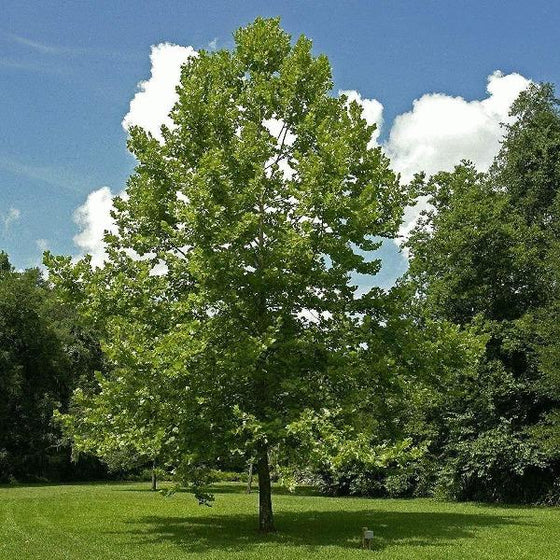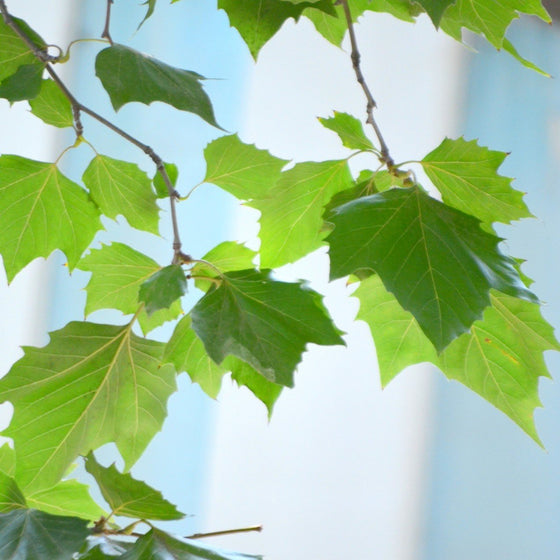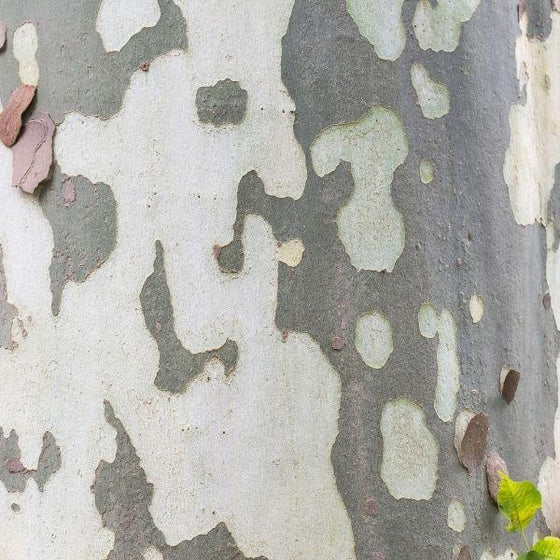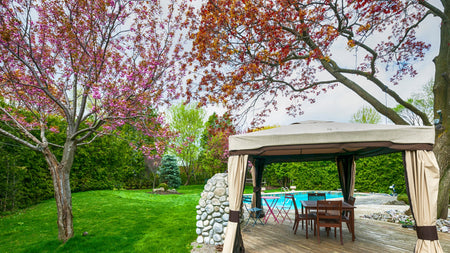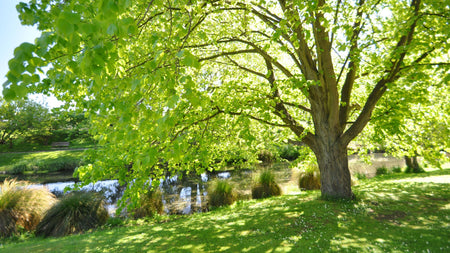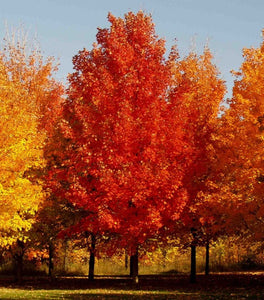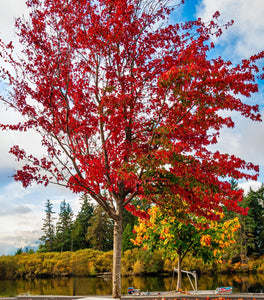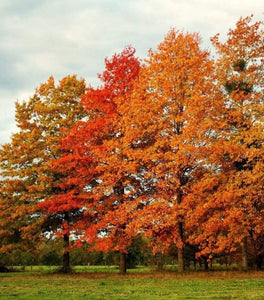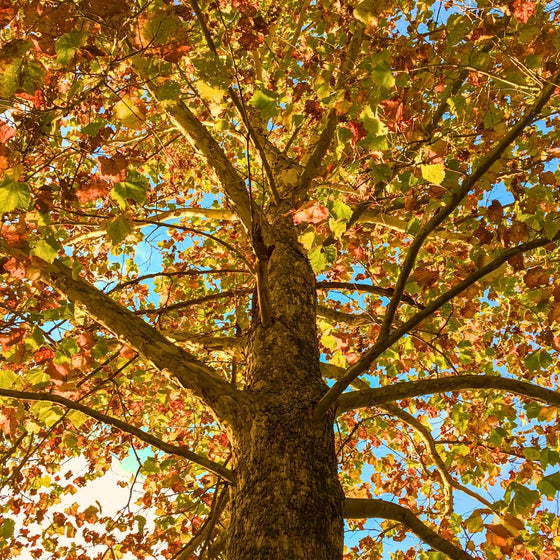
Images Depict Mature Plants
American Sycamore Trees
The American Sycamore Tree (Platanus occidentalis) is a majestic, fast-growing deciduous tree known for its towering height, broad canopy, and striking mottled bark. One of North America's largest native hardwoods, this iconic tree can reach heights of 75 to 100 feet or more, making it ideal for providing shade in large landscapes, parks, or open fields. Its peeling bark reveals patches of white, tan, and gray, creating a distinctive camouflage-like pattern that adds year-round visual interest and texture to the landscape.
In spring and summer, the American Sycamore boasts large, maple-like green leaves that offer dense shade, helping to cool the surrounding environment naturally. In fall, the foliage turns a soft yellow before dropping, while the tree produces small, round seed balls that persist into winter. Sycamore trees thrive in full sun and moist, well-drained soils, particularly in low-lying areas, streambanks, and floodplains, making them ideal for erosion control and natural reforestation efforts. Their adaptability to urban pollution and strong root systems also make them a common choice for public plantings and windbreaks.
Perfect for those looking to make a bold statement in the landscape, the American Sycamore Tree offers fast growth, exceptional hardiness (USDA Zones 4–9), and valuable ecological benefits. It supports a wide range of native wildlife, including birds and pollinators, and plays a role in stabilizing riparian ecosystems. Whether planted as a specimen tree or as part of a native shade tree or restoration project, Platanus occidentalis delivers timeless beauty, cooling shade, and unmatched landscape presence.
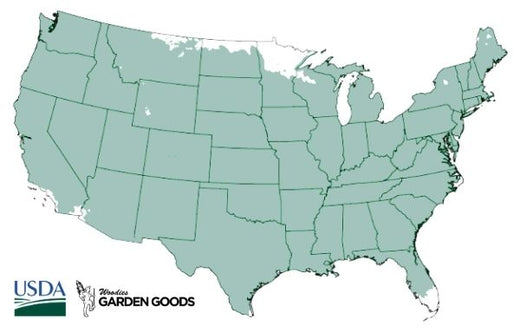
| Hardiness Zones: | 4-9 |
|---|---|
| Mature Height: | 70 to 80 feet |
| Mature Width: | 40 to 50 feet |
| Classification: | Broad Leaved deciduous tree, Shade Tree |
| Sunlight: | Full Sun |
| Habit: | Upright, Tall |
| Foliage: | Glossy Green,Yellow |
| Flower Color: | Inconspicuous |
| Pruning Season: | No pruning needed |
| Soil Condition: | Any well drained soil |
| Water Requirements: | Water well until established |
How to Care for American Sycamore Tree
Be sure to read our planting instructions to ensure healthy and happy American Sycamore Trees for years to come! for years to come!
How Do I Plant My American Sycamore Trees?
To plant your American Sycamore Tree (Platanus occidentalis), start by selecting a location with full sun and ample space, as this fast-growing native tree can reach heights of 75–100 feet with a broad, spreading canopy. It thrives in moist, well-drained soil but can also tolerate periodic flooding, making it an ideal choice for low-lying areas, streambanks, or large open lawns. Dig a hole two to three times the width of the root ball and just as deep. Carefully remove the tree from its container or burlap wrap, gently loosen any circling roots, and place it in the hole with the top of the root flare level with the surrounding soil. Backfill the hole with the original soil, pressing gently to eliminate air pockets, and water thoroughly to settle the soil around the roots. Apply a 2–3 inch layer of mulch around the base of the tree, keeping it a few inches away from the trunk to retain moisture and regulate soil temperature. Water your American Sycamore deeply once or twice a week during the first growing season to encourage strong root establishment. With the right planting technique and early care, your American Sycamore will grow into a majestic shade tree perfect for large landscapes and naturalized settings.
How Do I Water My American Sycamore Trees?
Watering your American Sycamore Tree properly is essential during the first few years to establish a deep, extensive root system. Newly planted sycamores should be watered deeply once or twice per week, providing about 1–1.5 inches of water each time, depending on rainfall and temperature. Focus on saturating the root zone, which extends just beyond the drip line, to encourage roots to grow downward and outward. Using a slow trickle from a hose or drip irrigation helps prevent runoff and ensures deep soil penetration, which is especially important for this fast-growing, moisture-loving tree. Once established, American Sycamore Trees become moderately drought tolerant but will grow best with occasional deep watering during extended dry periods, especially in hot summer months. These native giants naturally thrive along streambanks and moist lowlands, so maintaining consistent soil moisture will support vigorous growth and overall tree health. Applying mulch around the root zone helps retain moisture and reduce the frequency of watering. With proper irrigation, your American Sycamore will reward you with rapid growth, dense shade, and striking bark that adds beauty and structure to large landscape settings.
How Should I Fertilize My American Sycamore Trees?
Fertilizing your American Sycamore Tree promotes strong growth, healthy foliage, and resistance to stress. In early spring, before new growth begins, apply a balanced slow-release fertilizer such as a 10-10-10 or 20-20-20 formula around the root zone, keeping the granules at least a few inches away from the trunk. For young or newly planted trees, use a lower concentration to avoid overfeeding and encourage gradual, sturdy development. Water the area thoroughly after applying fertilizer to help nutrients penetrate the soil and reach the roots effectively. As your American Sycamore matures, it may benefit from annual feedings—especially if it's growing in poor or depleted soil. A soil test can determine nutrient deficiencies and guide any adjustments. Organic options like composted manure or leaf mold can also be worked into the soil to improve overall fertility and structure. Avoid high-nitrogen fertilizers late in the growing season, as they may encourage tender growth that’s susceptible to winter damage. With consistent, moderate feeding, your American Sycamore will maintain its signature fast growth and lush canopy, making it an excellent shade provider and focal point in large-scale landscapes.

How and When Should I Prune My American Sycamore Trees?
Pruning your American Sycamore Tree should be done during the dormant season, ideally in late winter or early spring before new growth begins. This timing reduces the risk of disease, especially anthracnose, which can affect sycamores when pruned during wet, active growing periods. Start by removing any dead, diseased, or damaged branches, as well as any crossing or inward-growing limbs that may hinder healthy airflow and light penetration. Proper structural pruning in young trees helps establish a strong, balanced framework, while mature sycamores may require occasional thinning to reduce limb weight and prevent breakage. Always use clean, sharp tools to make smooth cuts just outside the branch collar to encourage proper healing. Avoid excessive pruning, as over-thinning can stress the tree and promote weak regrowth. American Sycamores are fast growers, so regular monitoring and maintenance pruning every few years will help manage their size and shape, especially in residential landscapes or near structures. With proper pruning, your American Sycamore will develop a strong, open canopy, showcase its beautiful exfoliating bark, and thrive as a majestic shade tree in parks, large lawns, or riparian plantings.


